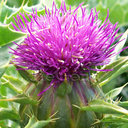Compositional difference in antioxidant and antibacterial activity of all parts of the Carica papaya using different solvents.
Ключевые слова
абстрактный
BACKGROUND
Carica papaya is a well known medicinal plant used in the West and Asian countries to cope several diseases. Patients were advised to eat papaya fruit frequently during dengue fever epidemic in Pakistan by physicians. This study was conducted to establish Polyphenols, flavonoids and antioxidant potential profile of extracts of all major parts of the C. papaya with seven major solvents i.e. water, ethanol, methanol, n-butanol, dichloromethane, ethyl acetate, and n-hexane.
RESULTS
TPC, TFC, antioxidant and antibacterial potential were determined using different aqueous and organic solvents in addition to the determination of trace element in leaves, pulp and peel of C. papaya. Total soluble phenolics and flavonoids were found in promising quantity (≈66 mg GAE/g) especially in case of methanol and ethanol extracts. Antioxidant activity using DPPH free radical scavenging assay indicated leaves, bark, roots and pulp extracts showed >75.0 % scavenging potential while leaves and pulp showed 84.9 and 80.9 % inhibition of peroxidation, respectively. Reducing power assay showed leaves, pulp and roots extracts active to reduce Fe(3+) to Fe(2+) ions. The antibacterial study showed pulp extract is the best to cope infectious action of bacteria.
CONCLUSIONS
This study was conducted to test the medicinal profile of all parts of C. papaya by extracting secondary metabolites with organic and aqueous solvents. Ethanol and methanol both were found to be the best solvents of choice to extract natural products to get maximum medicinal benefits and could be used to medicinal formulation against different infectious diseases.Graphical abstractMedicinal evaluation of different parts of C. papaya.






